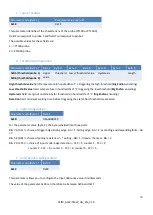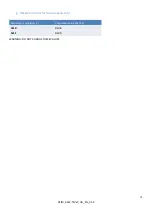
22
ATIM_ACW-TMxP_UG_EN_V1.0
Frames format
a.
Sigfox and LoRaWAN
Uplink frame
Byte 1
Byte 2
. . .
Byte n
Frame header
Frame specific data
We can differentiate three types of frames:
⚫
Classic frame; New generation
: Very similar to the old frames, the difference is that you can activate the
timestamp. These are for example the life frame, the error frame, the response to configuration frames, ...
These last frames are common to all ACWs but, it is also possible to have other independent frames for each
ACWs.
⚫
Measuring frame; New generation
: These frames consist of samples of the different values of each of the
channels that an ACW can read. Beforehand, the number of samples and the depth of the history will be
inserted in the header.
Notes
: The number of samples and the depth of the history are in common for all the
channels of the frame.
⚫
Alert frame (threshold crossing); New generation:
These frames combine a conventional frame and a
measurement frame. They consist of a header warning that a threshold has been exceeded, followed by
samples of each of the channels for which a threshold has been exceeded.
Classic frame
If the Timestamp is activated, 4 bytes with the Timestamp value will be preceded by the header (byte 1).
Byte 1 - header
Bit 7
Bit 6
Bit 5
Bit 4
Bit 3
Bit 2
Bit 1
Bit 0
New
generation= 1
Timestamp =
1 - enabled
0 - disabled
Measuring
frame= 0
Reserved= 0
Type of frame











































